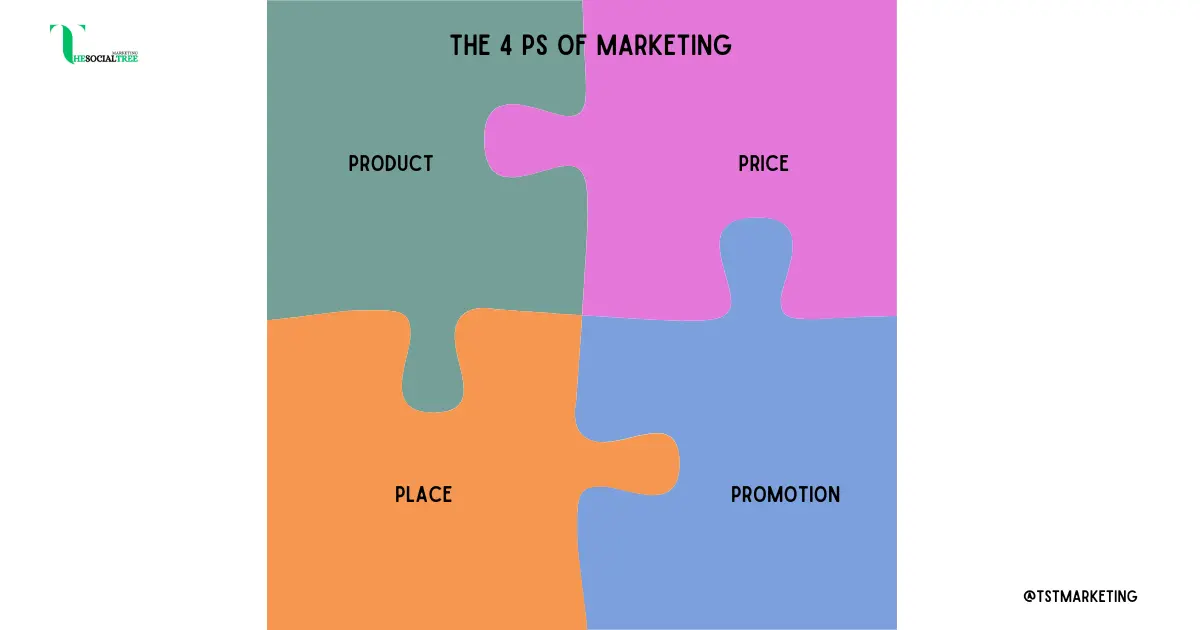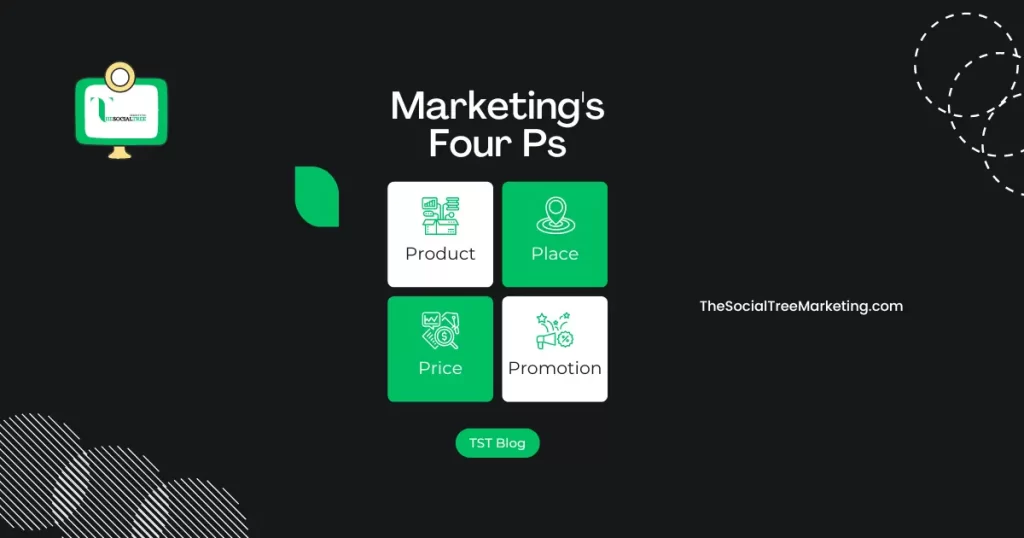The four Ps are Product (What you sell), Price (Price of the product), Place (Where are you selling), and Promotion (Where and how to promote) in the dynamic landscape of marketing. Additionally, the four Ps are the pivot of marketing. Effective marketing strategies should involve the four Ps. The 4 Ps work together and become the backbone for businesses attempting to bloom in competitive marketing.
In addition, the four Ps in marketing are evaluative because they provide an extensive framework for developing successful marketing strategies that fulfill customer needs and drive business success. Besides that, the four Ps work together to produce stability and successful marketing strategies.
Moreover, a valuable product offered at a suitable place, available in the appropriate locations, with good promotion and a suitable price, can remarkably increase a business’s ability to captivate and retain customers. Hence, the four Ps are the base of any successful marketing strategy. They will also help you find out and fulfill the needs of customers.
What are the 4 Ps of marketing?

1– Product 2– Price 3– Place 4– promotion
1- Product
The keystone of any marketing strategy is the product, containing the core of what a company brings to the market. Even, a physical product such as a smartphone or an immaterial service like a financial consulting, the products or services indicate the touchable or untouchable value proposition offered to customers.
In addition, understanding the target audience is necessary for product development. You can tailor your products to address particular market requirements successfully, such as the needs, preferences, and pain points of the customers.
The product development process includes substantial market research, customer feedback, and tendency analysis of the available data. However, crafting captivating products requires careful attention to detail across different dimensions.
Firstly, You should focus on creative designs. The design is necessary for product development in shaping the user experience and product insights. Attractive appeals, user-oriented considerations, and innate functionality give a positive user experience and drive customer contentment.
Secondly, the quality of the product is absolute. Even if, it is longevity, solidity, or performance, customers look for products that provide on their assurances and fulfill their needs. Additionally, providing high-quality products can enhance customer trust and boost the brand’s reputation.
Thirdly, the most important factor in the product development is packaging. Packaging usually impacts customer insights and purchase decisions. Implied packaging protects the product as well as works as a vehicle for branding.
In the meantime, continuous revolution is crucial to staying ahead in today’s energetic market. If you want continuous development of your products to fulfill changing needs, technological advancements, and competitive pressure focus on updated and new changes.
In summary, the product includes a touchable or non-touchable value proposition provided by a brand or company to its customers. Businesses can create captivating products that match their target audience by aligning customers’ needs, maintaining high-quality, creative, and innovative designs, and successful packaging.
2- Price
Price is an analytical component of any marketing plan, as it directly impacts a company’s revenue, profitability, and market positioning. Moreover, it includes setting a fair price for a product or service, considering different aspects like production costs, the competitive landscape, and customer behavior.
Furthermore, pricing is about discovering the fine balance between cost considerations and recognizing value. The price should consider the value that customers recognize in the product or service, while also covering the costs of its production, distribution, and marketing.
In addition, one of the most important considerations in pricing strategy is figuring out market dynamics. It requires analyzing the following aspects supply and demand, market tendencies, and competitive pricing strategies. Additionally, you can recognize pricing opportunities and threats by understanding the wide market context that enables you to modify your pricing strategies accordingly.
Next, consumer behavior is very essential in pricing decisions. Therefore, businesses must divide their target market and tailor their pricing strategies to serve the needs and preferences of their customers.
In addition, competitive positioning is also a powerful aspect that impacts pricing strategy. Businesses must evaluate their competitors’ pricing strategies, and product offerings to analyze how their prices will be identified in the market.
Lastly, market research and analysis are crucial in analyzing the most favorable pricing strategy. Usually, this includes gathering data on customer preferences, price flexibility, competitor pricing, and market tendencies.
To sum up, pricing strategy is an analytical element of marketing that requires attentive consideration of cost, value, market dynamics, and customer behavior. Additionally, you can improve your marketing strategies to increase revenues and profitability by embracing a strategic approach to pricing.
3- Place
“Be Where the World is Going.”
By: Beth Comstock
Place is another component of the marketing blend that emphasizes how products or services are made available to customers. Additionally, it is also called distribution. It includes the whole journey from production provisions to the hands of end consumers and surrounds different activities like transportation, warehousing, inventory management, and sales.
A place strategy focuses on that customers can reach the products when and where they need them. It requires attentive planning and integration to smooth the distribution process and reduce barriers between production and consumption.
In the meantime, one of the most important factors in place strategy is logistics, which includes the fluctuation and storage of products throughout the supply chain. Well-organized logistics is crucial for ensuring timely delivery; reducing costs, and improving inventory levels.
In addition, inventory management is another analytical element of the place strategy. It includes balancing supply and demand to keep away from stockouts or overstock conditions. Using inventory optimization techniques businesses can reduce their products’ carrying costs. Two well-known inventory optimization techniques are just-in-time inventory and demand forecasting.
Last but not least, retail channels are very necessary parts of the place strategy. Retail channels work as the interface between you as a business and consumers. Accessing customers in different geographic locations and market segments, and building a robust network of retailers is crucial.
In short, place strategy is essential to ensuring that products or services are reachable to customers at the right time and place. Businesses can increase their market reach, boost customer satisfaction, and drive business success by using this effective strategy.
4- Promotion
Promotion is also important in the marketing blend. It involves the following activities spreading awareness, generating interest, and convincing customers to purchase a product or service. Additionally, promotion works as a bridge between businesses and consumers.
Moreover, promotion is about successfully communicating the value theory of a product or service to the target audience. It includes crafting captivating messages that focus on the benefits, features, and distinct selling points.
Furthermore, one of the basic strategies of promotion is advertising. Advertising includes communication through different media channels like television, radio, print, billboards, and digital platforms. Additionally, advertising enables businesses to access a wider audience and spread brand awareness through compelling messages, storytelling, etc.
In addition, public relations campaigns are another essential component of promotion. Promotion emphasizes managing the reputation of a brand through earned media coverage. Some important PR activities involve media relations, press releases, events, and sponsorships. They focus on increasing brand loyalty and trust and enhancing positive relationships between you and stakeholders.
Additionally, sales promotions are small reasons designed to restore instant purchasing action from customers. Sales promotion usually involves discounts, coupons, rebates, and loyalty programs that focus on encouraging purchases and driving sales. Buyer persona is also helpful in this strategy.
In the light of digital marketing brand promotion strategies have transformed. Now businesses can take advantage of new channels and tools to access and engage customers online. Some powerful and effective methods for the promotion of a brand are social media marketing, content marketing, email marketing, and SEO (Local SEO or Social SEO). Additionally, you must know the target audience for the promotion of a product or service effectively.
In conclusion, the four Ps are powerful tools in marketing. The four Ps allow businesses to negotiate the complications of the market landscape. Moreover, the four Ps anticipate customer needs and create value that strongly matches the target audience. Additionally, businesses can build meaningful relationships with customers, drive acceptable growth, and achieve lasting success by embracing the four Ps.

